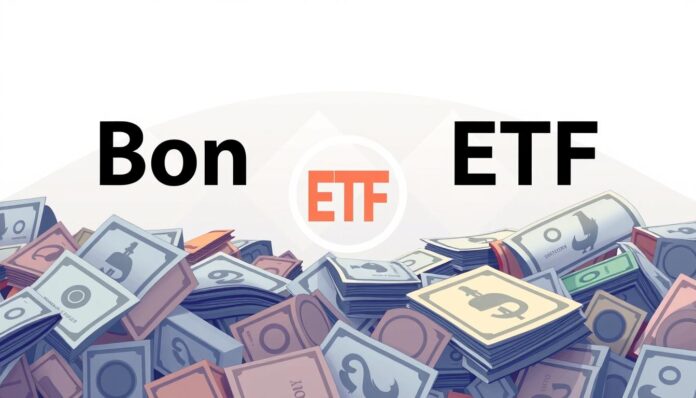Bond ETFs are investment funds that hold bonds instead of stocks. They trade on stock exchanges like individual stocks, making them easy to buy and sell. A bond ETF definition includes their role in giving investors access to a diversified mix of bonds, from government issues to corporate debt. These funds track specific bond indexes, offering a simple way to own a slice of many bonds at once.
Key Takeaways
- Bond ETFs bundle bonds into tradable shares for investors.
- They provide diversification across different types of debt securities.
- Unlike individual bonds, ETFs can be traded throughout market hours.
- Costs are typically lower than buying bonds directly.
- They simplify exposure to government, corporate, or municipal bonds.
Understanding Bond ETFs
Bond ETFs Explained are investment tools that simplify access to fixed-income markets. These funds pool investor money to buy baskets of bonds, offering a flexible way to gain exposure without buying individual bonds. Let’s break down how these work and why they matter.
Definition of Bond ETFs
Bond ETFs are exchange-traded funds that hold a portfolio of bonds. Unlike mutual funds, they trade throughout the day on stock exchanges. This structure allows investors to buy or sell shares in the fund just like stocks, making them more accessible than traditional bond investments.
How They Work
- Creation/Redemption: Authorized participants exchange bonds for ETF shares in large blocks, maintaining supply and demand balance.
- Index Tracking: Many Bond ETFs mirror indexes like the Bloomberg Barclays U.S. Aggregate Bond Index, aiming to replicate their performance.
- Trading: Traded on exchanges like NYSE or Nasdaq, prices update in real time, unlike mutual funds priced at day-end.
Key Benefits of Investing in Bond ETFs
Investors gain three core advantages:
- Diversification: Exposure to dozens or hundreds of bonds reduces risk tied to a single issuer.
- Transparency: Daily disclosure of holdings lets investors see exactly what’s in the portfolio.
- Cost Efficiency: Lower expense ratios compared to bond mutual funds, making them budget-friendly.
Types of Bond ETFs
Understanding Types of Bond ETFs helps investors match their goals with the right investment. Bond ETFs explained through these categories simplify choosing options tailored to risk tolerance and financial objectives.
Government Bond ETFs
Government bond ETFs invest in debt issued by national governments. These are seen as low-risk due to strong creditworthiness of issuers like the U.S. Treasury. Returns are typically stable but moderate.
Corporate Bond ETFs
Corporate bond ETFs hold debt from companies. These offer higher yields than government bonds but come with greater credit risk. Investment-grade corporate ETFs balance risk and reward.
Municipal Bond ETFs
Municipal bond ETFs fund public projects. Interest payments are often exempt from federal taxes, making them attractive for high-income investors. State-specific tax benefits may apply.
High-Yield Bond ETFs
High-yield bond ETFs (or “junk bond” ETFs) target lower-rated corporate debt. They promise higher returns but carry significant default risks. Suitable for aggressive investors.
| Type | Risk Level | Tax Considerations | Example ETF |
|---|---|---|---|
| Government | Low | Federal taxes apply | iShares U.S. Treasury Bond ETF |
| Corporate | Moderate | Taxed as ordinary income | iShares iBoxx $ Investment Grade |
| Municipal | Low | State tax exemptions possible | Vanguard Municipal Bond ETF |
| High-Yield | High | Taxed as income | SPDR Bloomberg Barclays High Yield |
Research shows government bond ETFs saw $2.3 trillion in assets under management in 2023, highlighting their popularity for safety. Always review fund prospectuses before investing.
Why Invest in Bond ETFs?
Exploring Investing in Bond ETFs reveals compelling reasons to consider these tools. Their structure offers practical advantages tailored to varying financial goals.
Diversification of Portfolio
Bond ETFs pool assets into a single holding, spreading risk across dozens or hundreds of bonds. This diversification reduces dependency on any single issuer. For instance, a corporate bond ETF might include bonds from utilities, tech, and healthcare sectors. Such broad exposure helps shield portfolios from sector-specific downturns. Investors gain access to a balanced mix without buying individual bonds, a key Benefit of Bond ETFs.
Regular Income Stream
Many bond ETFs distribute interest payments quarterly. Investors receive steady payouts as underlying bonds pay coupons. This makes them popular with retirees or those seeking supplemental income. Unlike individual bonds that lock funds until maturity, ETF dividends provide ongoing cash flow without selling shares.
Liquidity of Bond ETFs
Unlike traditional bonds, which can face thin trading markets, bond ETFs trade like stocks all day. This Benefit of Bond ETFs means investors can buy or sell quickly at current prices. Compare this to corporate bonds often traded over-the-counter with wider bid-ask spreads. ETF liquidity supports active strategies while minimizing price impact during trades.
For those Investing in Bond ETFs, these features combine to offer stability and flexibility. Whether targeting income, risk reduction, or accessible trading, bond ETFs simplify access to fixed-income markets without the complexity of managing individual holdings.
Risks Associated with Bond ETFs
Like all investments, Bond ETF Risks are real and worth understanding when Investing in Bond ETFs. While bond ETFs offer diversification and income, they also come with potential downsides that require careful consideration.

Interest Rate Risk
Rising interest rates can reduce the value of existing bonds in an ETF. For example, when rates climb, prices of older bonds with lower coupon rates drop. Treasury and long-term bond ETFs face this risk most sharply. Duration, a measure of price sensitivity, helps gauge exposure here.
Credit Risk
Bond issuers might default on payments, especially in high-yield ETFs holding lower-rated corporate or municipal bonds. Diversification in ETFs lessens—but doesn’t eliminate—this risk. Always check the credit quality of underlying holdings.
Market Risk
Market-wide downturns can affect bond ETF prices, even during stable interest rates. Economic recessions or geopolitical events may lead to sell-offs, impacting liquidity and pricing temporarily.
Inflation Risk
Rising inflation erodes purchasing power, reducing real returns on fixed-income payments. Short-term bond ETFs or inflation-protected securities like TIPS may offer better defense against this risk.
How to Invest in Bond ETFs
Ready to start Investing in Bond ETFs? Here’s a step-by-step guide to simplify the process:
Selecting the Right Bond ETF
Begin by researching ETFs using key metrics like expense ratios and yield. Look for funds tracking reliable indexes such as the Bloomberg Barclays U.S. Aggregate Bond Index. Consider duration to match your risk tolerance.
- Check expense ratios: Lower costs mean more returns
- Verify tracking error to ensure accurate index replication
- Compare yields to identify income potential
Opening a Brokerage Account
Choose a brokerage that offers low fees and ETF access. Popular platforms include:
| Brokerage | Fee Structure | ETF Options |
|---|---|---|
| Fidelity | No trade commissions | Over 200 bond ETFs |
| Vanguard | Discounts for investors | Index-focused funds |
| Charles Schwab | No ETF fees | Advanced research tools |
Placement of Orders
When buying, choose between:
- Market orders: Execute immediately at current prices
- Limit orders: Set price limits to control costs
Always review fees and confirm trades before finalizing. Stay informed on How Bond ETFs Work to optimize timing and strategy.
Performance of Bond ETFs
Investors often ask how Bond ETF Performance stacks up against other options. This section breaks down what drives results and how they compare to holding Bond ETF vs Individual Bonds. Let’s explore what matters most.
Historical Performance Analysis
Past trends show Bond ETF Performance varies with market conditions. For example, during 2020’s low-rate environment, broad-market bond ETFs like the iShares iBoxx $ Investment Grade Corporate Bond ETF (LQD) held steady. Downturns, like 2013’s taper tantrum, revealed how ETFs adapt faster to rate shifts compared to individual bonds.
Comparison to Direct Bond Investments
Comparing Bond ETF vs Individual Bonds highlights key trade-offs. ETFs offer instant diversification—owning a slice of 100+ bonds at once—while individual bonds lock investors into single issuers. Here’s how they stack up:
- Income: ETFs pay dividends monthly vs. individual bonds’ fixed coupon dates.
- Liquidity: ETFs trade like stocks daily; individual bonds may take days to sell.
- Risk: ETFs spread risk across holdings, reducing default impact.
Factors Influencing Performance
Interest rates are a major driver. Rising rates hurt prices of existing bonds in ETFs, but newer purchases benefit from higher yields. Expense ratios matter too—lower costs boost net returns over time. Credit quality shifts can trigger price swings, especially in high-yield ETFs.
Costs Involved with Bond ETFs
When Investing in Bond ETFs, three key costs shape your returns: expense ratios, fees compared to mutual funds, and trading expenses. Knowing these helps you choose wisely.
Expense Ratioss Explained
Expense ratios are annual management fees. For example, a 0.10% ratio on a $10,000 investment costs $10 yearly. Over 10 years, this grows to $100. Lower ratios keep more money in your portfolio.
- Calculated as a percentage of your investment.
- Typically 0.05%–0.50% annually.
- Compound effects over time.
Comparison of Costs with Mutual Funds
Bond ETFs often cost half what mutual funds charge. Mutual funds may add sales loads (up to 5% upfront), while ETFs avoid this. When comparing Bond ETF vs Individual Bonds, costs diverge. Individual bonds lack expense ratios but face higher broker fees or markups. For instance, a corporate bond trade might charge $50 per trade, while ETFs offer bulk pricing.
Trading Fees and Commissions
Today’s brokers often offer zero-commission trading. Still, hidden costs exist. Bid-ask spreads (the difference between buy/sell prices) and potential ETF premiums/discounts affect net returns. Always check for unexpected charges.
Smart moves: Prioritize low-cost ETFs, compare bid-ask spreads, and avoid overtrading.
Tax Considerations for Bond ETFs
When Investing in Bond ETFs, tax strategies matter. This section breaks down how taxes affect returns, comparing Bond ETF vs Individual Bonds to help you plan smarter. 
Tax Treatment of Interest Income
Interest from most bond ETFs is taxed as ordinary income. Municipal bond ETFs offer state tax exemptions. Investors should note how their choice impacts taxable income.
Capital Gains Tax
Selling ETF shares at a profit may trigger capital gains taxes. Key points:
- ETFs often distribute fewer capital gains due to in-kind transfers
- Investors pay taxes when selling shares above purchase price
- Compare to holding individual bonds, which may face capital gains if sold early
Tax Efficiency of Bond ETFs
Bond ETFs can be more tax-efficient than Individual Bonds due to their structure. For instance, ETFs use in-kind redemptions to reduce taxable distributions. A key comparison:
“Tax efficiency is a key advantage of Bond ETFs over holding individual bonds directly.”
| Factor | Bond ETF | Individual Bond |
|---|---|---|
| Interest Income | Ordinary income tax (except municipal) | Taxed similarly to ETFs for corporate bonds |
| Capital Gains | Lower due to structural efficiencies | Taxed when sold before maturity |
| Overall Efficiency | Higher due to ETF mechanics | Less efficient for frequent trading |
Consult a tax advisor to align strategies with your unique situation. Tax rules vary by state and holdings.
Bond ETF vs. Traditional Bonds
Choosing between Bond ETF vs Individual Bonds depends on your financial goals. Both options offer income potential, but they differ in how they work and perform. Let’s break down these differences to help you decide.
Key Differences
| Feature | Bond ETF | Individual Bond |
|---|---|---|
| Maturity Dates | No fixed maturity | Fixed maturity date |
| Interest Payments | Monthly distributions | Semiannual payments |
| Trading | Traded like stocks | Traded over-the-counter |
Pros and Cons
Bond ETFs offer What Is A Bond ETF benefits like diversification and liquidity. They’re ideal for hands-off investors seeking flexibility. However, they lack principal protection if sold before maturity. Individual bonds give steady income and predictable returns when held to maturity. Their downside? Lower liquidity and higher purchase costs.
When to Choose Each
- Pick Bond ETFs for smaller portfolios needing instant diversification
- Choose individual bonds if you need exact maturity dates for specific financial goals
- Use ETFs for active traders; hold individual bonds for tax-advantaged municipal options
Neither option is better overall—it’s about matching your strategy. Assess your timeline, risk tolerance, and liquidity needs to pick the right fit.
Popular Bond ETFs in the Market
Many investors rely on well-established bond ETFs to build diversified portfolios. Below are three widely held options, each representing different Types of Bond ETFs with distinct risk and return profiles. Always research thoroughly before deciding.
| ETF Name | Focus | Expense Ratio | Yield | Duration | 3-Year Avg. Return |
|---|---|---|---|---|---|
| iShares iBoxx $ Investment Grade Corporate Bond ETF (LQVI) | Investment-grade corporate bonds | 0.15% | 4.1% | 8.2 years | 3.8% (annualized) |
| Vanguard Total Bond Market ETF (BND) | U.S. investment-grade bonds | 0.05% | 3.9% | 6.0 years | 2.9% (annualized) |
| SPDR Bloomberg Barclays High Yield Bond ETF (JNK) | High-yield corporate bonds | 0.25% | 5.3% | 4.8 years | 4.5% (annualized) |
iShares iBoxx $ Investment Grade Corporate Bond ETF
Offers exposure to top-rated corporate bonds. Its low expense ratio helps maximize returns, and Bond ETF Performance has historically matched market trends. Ideal for income-focused portfolios.
Vanguard Total Bond Market ETF
Covers nearly the entire U.S. bond market. With one of the lowest fees at 0.05%, it’s a core holding option. Performance aligns closely with broad market movements.
SPDR Bloomberg Barclays High Yield Bond ETF
Risk-tolerant investors may favor this fund’s higher yields. Its Bond ETF Performance reflects higher volatility but potential for growth. Always assess credit risks before investing.
These examples show how different Types of Bond ETFs cater to varying strategies. Performance history doesn’t guarantee future results, so review goals and risk tolerance first.
The Future of Bond ETFs
As investors continue to explore Bond ETF Performance, the bond ETF landscape is set to evolve through innovation and shifting market dynamics. Emerging trends, from ESG integration to cost reductions, will shape how these funds serve investors. This section outlines what to expect next.
Trends to Watch
Three key trends are gaining momentum:
- ESG-focused bond ETFs addressing sustainability goals
- Rising adoption of active management strategies
- Continued fee reductions driven by competition
Market Predictions
Analysts forecast Bond ETF Performance will hinge on:
| Scenario | Potential Impact |
|---|---|
| Rising interest rates | May pressure yields but boost short-term options |
| Economic slowdown | Could favor government bond ETFs as safe havens |
Innovations in Bond ETFs
New developments aim to enhance accessibility and customization:
- Direct indexing strategies for tailored exposure
- AI-driven portfolio rebalancing tools
- Blockchain for improved transparency in holdings
These advancements could redefine how investors interact with What Is A Bond ETF as dynamic instruments.
Frequently Asked Questions about Bond ETFs
Have questions about how bond ETFs work or fit into your strategy? This section breaks down common concerns to help you make informed decisions.
Common Misunderstandings
Bond ETF Definition often involves clarifying myths like the idea that prices rise when interest rates go up—the opposite is true. Dividends from bond ETFs usually reflect interest payments from underlying bonds, not guaranteed returns. Unlike traditional bonds, Bond ETFs don’t promise principal protection, so market fluctuations can affect value. Understanding these basics avoids confusion.
How to Choose the Right ETF
Selecting the best option starts with your goals. If you prefer stability, government or investment-grade Bond ETFs like the iShares iBoxx ETF may suit you. For higher risk tolerance, high-yield Bond ETFs offer potential gains but carry higher Bond ETF Risks. Always check expense ratios and liquidity to ensure alignment with your time horizon and risk profile.
Are Bond ETFs Suitable for Everyone?
While Bond ETFs offer diversification and liquidity, they’re not one-size-fits-all. Conservative investors might favor short-term ETFs to limit interest rate exposure. Those needing fixed income can pair them with stocks for balance. However, investors averse to market volatility might prefer direct bond holdings. Assess your portfolio needs and consult a financial advisor to decide what’s right for you.

